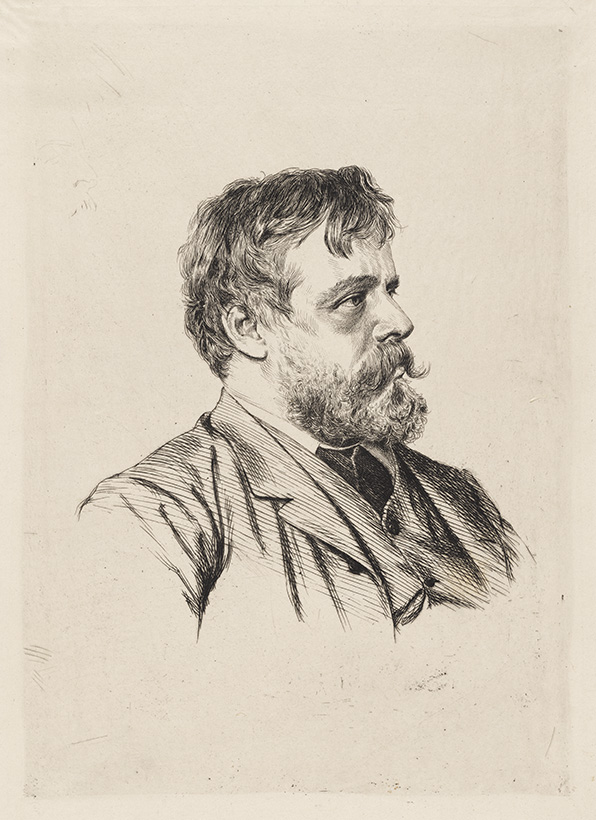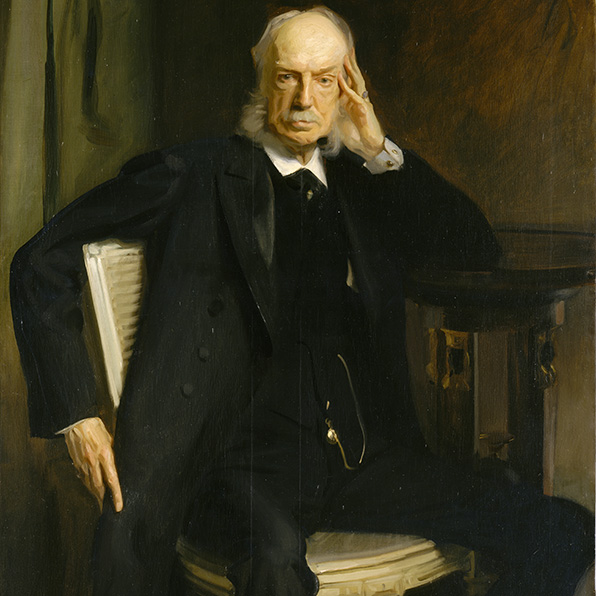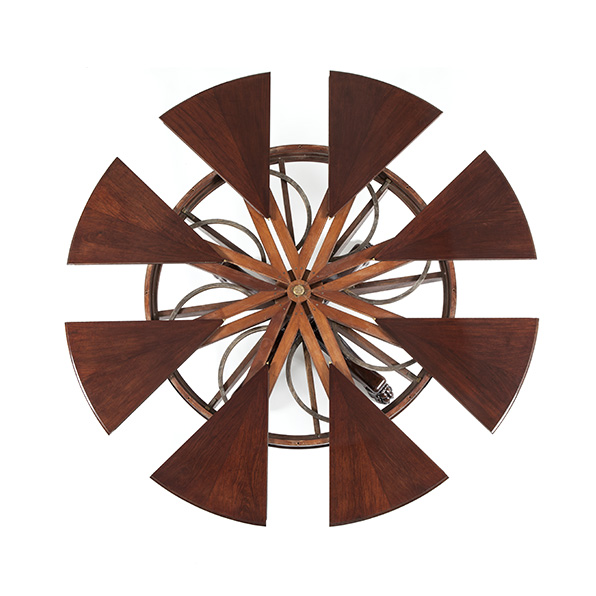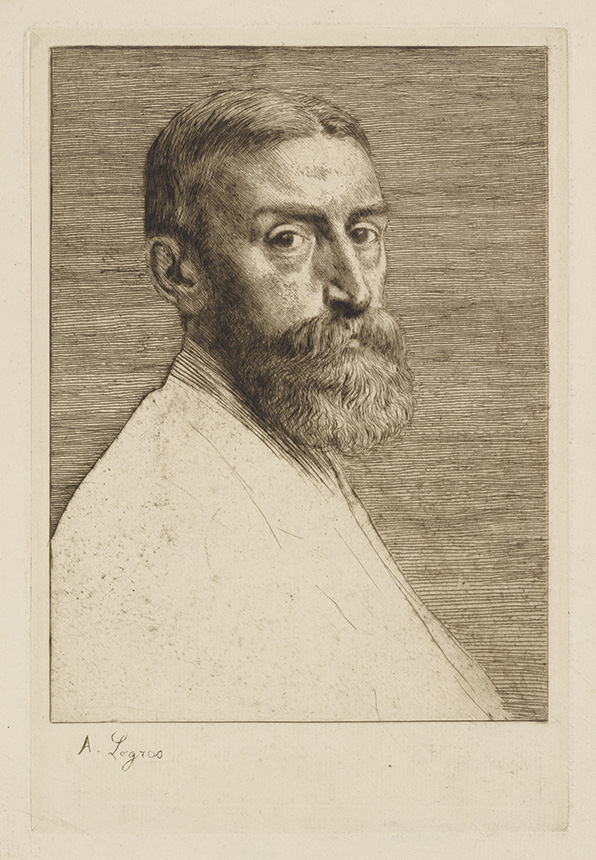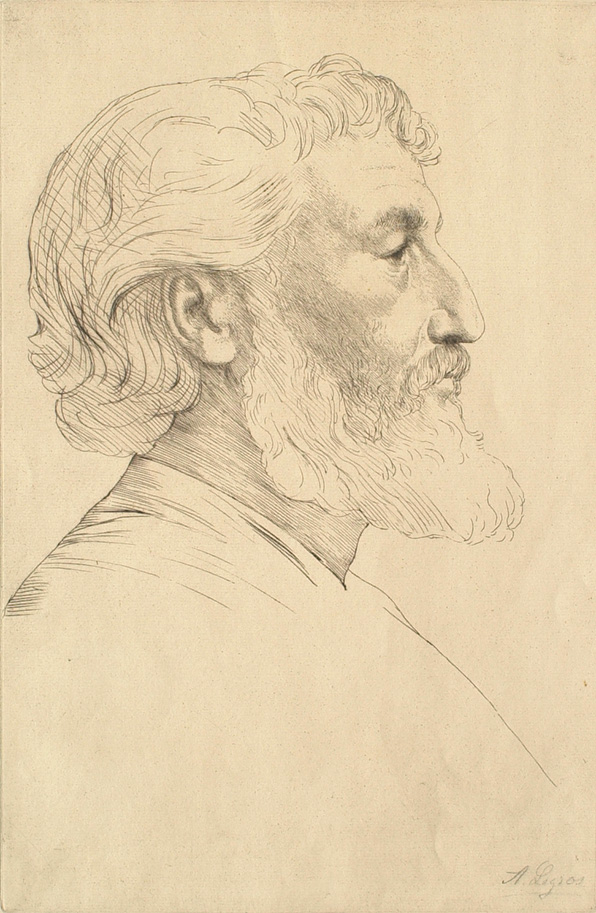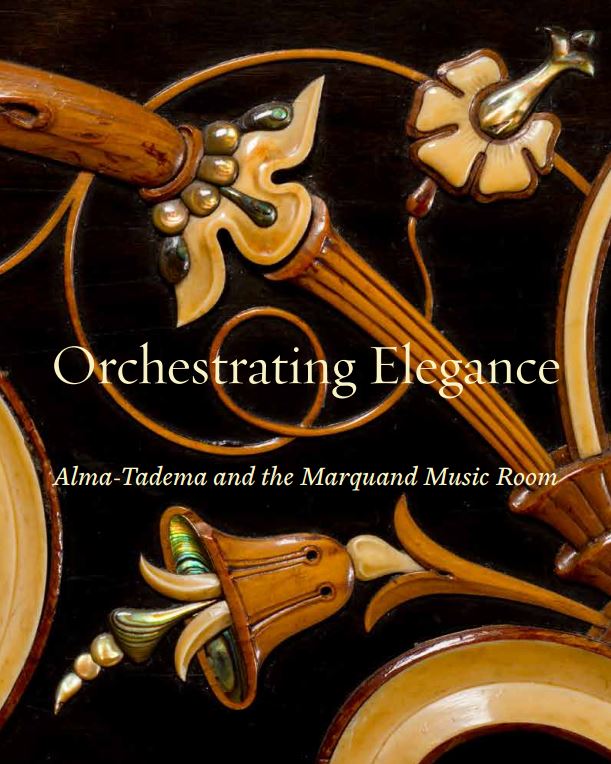
JUNE 4–SEPTEMBER 4, 2017
THE MAKERS OF THE MARQUAND MUSIC ROOM
LAWRENCE ALMA-TADEMA
Paul-Adolphe Rajon (French, 1842/43–1888)
Lawrence Alma-Tadema, 1883
Etching on paper
Clark Art Institute
Anonymous gift, 2016.6
Lawrence Alma-Tadema (1836–1912) was born Laurens Alma Tadema in the Netherlands. After training to become a painter at the Royal Academy in Antwerp, Belgium, he settled in London. At some point, he anglicized his first name and combined his middle and last names (Alma and Tadema) so that his name would appear near the beginning of alphabetized lists of exhibitors. As an artist, he became highly adept at evoking quotidian scenes from different historical periods, and, following a trip to Rome, Naples, and Pompeii in 1863, his focus increasingly turned toward the re-creation of scenes of ancient Greece and Rome. Excelling in the ability to represent different materials—marble, metalwork, fabrics—his paintings combined his technical prowess with a profound study of the visual evidence of classical antiquity. His theatrical and usually lighthearted paintings garnered him increasing international fame. After Queen Victoria knighted him in 1899, he was known as Sir Lawrence Alma-Tadema. Alongside his fame as a painter, Alma-Tadema achieved renown during his lifetime for the artistic and eclectic designs of his own domestic interiors.
HENRY GURDON MARQUAND
John Singer Sargent (American, 1856–1925)
Henry G. Marquand, 1897
Oil on canvas
Lent by The Metropolitan Museum of Art, New York
Gift of the Trustees, 1897, 97.43
Image © The Metropolitan Museum of Art. Image Source: Art Resource, NY
Henry Gurdon Marquand was born in New York, the youngest of eleven children whose family owned a jewelry and silver business. Marquand developed keen business instincts and made his fortune largely through railroads and the insurance industry. As his wealth grew, so did his interest in art, and he was among the committee who founded The Metropolitan Museum of Art in 1870. Serving as the Metropolitan’s president from 1889 until his death, Marquand devoted the final decades of his life to acquiring art both for the museum and for his personal collection. He donated many notable works to the museum, including masterpieces by Anthony Van Dyck, Rembrandt, and Vermeer. In 1897, the Metropolitan commissioned John Singer Sargent to paint a portrait of Marquand for its collection.
Marquand made his fortune in business and became an important collector and patron of the arts. As a young man, he attended boarding school in Pittsfield, Massachusetts, and later married a woman from a prominent Pittsfield family, Elizabeth Love Allen (1826–1895). The couple had six children and built luxurious houses in Newport, Rhode Island, and New York City. Both houses were designed and built by Richard Morris Hunt, who also was responsible for the building that continues to serve as the main entrance to The Metropolitan Museum of Art. Marquand’s New York house, located on the northwest corner of 68th Street and Madison Avenue, was built in what was called French Renaissance style and was filled with distinctive spaces that combined elaborate architectural detail with displays of Marquand’s notable collections of European paintings, Asian decorative arts, Renaissance tapestries and sculpture, and ancient Greek and Roman ceramics. One member of the press called the mansion “Hunt’s masterpiece.”
JOHNSTONE, NORMAN & CO., 67 NEW BOND STREET, LONDON
Johnstone, Jupe & Co., London
“Jupe’s Patent” Extending Dining Table, c. 1839
Mahogany
Lent by Apter-Fredericks Ltd., London
When Alma-Tadema received the music room commission, he turned to a furniture-making firm that had been in business in London since at least 1807. The firm’s name varied over time, reflecting changes in ownership, with “Johnstone” as the constant. Alma-Tadema described Johnstone, Norman & Co. to Marquand as “the people who work generally for me and understand my wishes.” It is likely that they had previously made a number of pieces of furniture for the artist, such as a pair of studio benches he used as props for many of his paintings. The firm had a reputation for fine-quality products and precision craftsmanship. The furniture they made for the Marquand music room increased their fame exponentially, likely stimulating the launch of an ambitious but ultimately unsuccessful (even ruinous) attempt to attract more business from wealthy Americans. Within a few years of the success of the Marquand suite, which was lauded in newspapers and journals on both sides of the Atlantic, the firm faced bankruptcy and was taken over by another furniture firm, though it continued to operate under the same name until around 1911.
Among the most famous of the firm’s products was an expandable dining table, patented by firm principal Robert Jupe in 1835. Jupe’s innovative table expanded radially, with segments of the table moving along tracks away from the center and the resulting openings filled by expertly fitted inserts. This allowed the table to accommodate various-sized dinner parties without the inconvenience of cumbersome attachments or table legs placed in the way of diners’ chairs. The ingenious mechanism is simple to use and reliable—after a lifespan of nearly 180 years, the table functions perfectly.
"Jupe's Patent" Extending Dining Table at the Clark
EDWARD POYNTER
Alphonse Legros (French, 1837–1911)
Edward Poynter, 1877
Etching and drypoint on paper
Clark Art Institute, 1985.44
Edward Poynter (English, 1836–1919) had a distinguished career as an artist and an arts administrator. Like Alma-Tadema, he is known for his academic painting style and often set his painted scenes in antiquity. He served as director of the National Gallery in London from 1894 to 1905. In 1896—the same year he was knighted—Poynter was elected president of the Royal Academy, a post he held for twenty-two years. He died in 1919 and is buried in the crypt of Saint Paul’s Cathedral, not far from Sir Lawrence Alma-Tadema.
In early 1886, Alma-Tadema engaged Poynter to paint the interior of the fallboard (the lid that closes to cover the piano keys) for the Marquand piano, an element of the instrument’s design that elicited enormous praise. Poynter’s finished painting, known as The Wandering Minstrels, shows a panoramic scene of musicians and dancers in an idyllic landscape.
FREDERIC, LORD LEIGHTON
Alphonse Legros (French, 1837–1911)
Sir Frederic Leighton, 1878
Etching and drypoint on paper
Clark Art Institute, 1987.54
Legros’s portrait of Frederic Leighton was made at the time Leighton was knighted by the Queen and ascended to the presidency of the Royal Academy of Art, an influential position he held until his death in 1896. Largely trained in Europe, Leighton was a consummate draftsman celebrated for his portraits of his contemporaries as well as subjects taken from classical mythology. He was also a noted sculptor, and with the help of architect George Aitchison (1825–1910), he created a celebrated artistic home in London’s Holland Park, replete with an “Arab Hall” decorated with Islamic tiles from Damascus.
Alma-Tadema enlisted Sir Frederic Leighton to paint decorative canvases for the Marquand music room ceiling. Leighton’s three panels, measuring seven feet high by twenty feet wide, featured large, classically robed female figures. Those in the center panel represented the Greek muse of tragedy, the mother of the muses, and the muse of comedy. Set against a rich gold background, these figures and accompanying winged cherubs, tripods, and ancient musical instruments complemented the classical decorative scheme of the Marquand music room and emphasized its musical function.
A fully illustrated catalogue, edited by Kathleen M. Morris and Alexis Goodin with contributions by Kathleen M. Morris, Alexis Goodin, Melody Barnett Deusner, and Hugh Glover, accompanies the exhibition. This beautiful publication documents and examines the celebrated design of an elaborate music room for financier, art collector, and philanthropist Henry Gurdon Marquand by eminent British painter Sir Lawrence Alma-Tadema. The catalogue is published by the Clark and distributed by Yale University Press. Call the Museum Store at 413 458 0520 to order.

